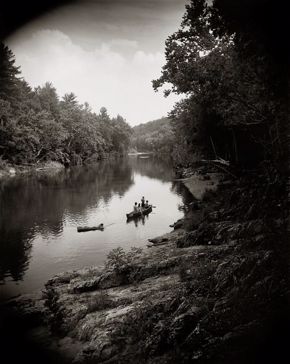Southern Exposures: The Photography of Sally Mann February 14, 2019
Born in Lexington, Virginia, in 1951, photographer Sally Mann grew up on family land amid the rolling hills alongside the Maury River, just outside of town. There, she raised her own children and found inspiration in both the landscape and in the easy, natural way of life that the area encouraged. “It’s always been my philosophy to try to make art out of the everyday and ordinary,” she observed. “It never occurred to me to leave home to make art.”
Through a Southern Lens
For more than four decades, Mann has chosen the South—its exquisite landscape, antebellum relics, and fraught history—as a subject or setting through which to explore memory and mortality; the lasting bonds of family and the legacy of slavery; and the beauty of nature and its indifference to human endeavor. Despite their diverse subjects, her photographs share an elegiac quality—a quality Mann emphasized by using a large, antique view camera and, later, the 19th-century “wet plate” process (collodion-on-glass negatives). Some of her photographs show her children at play: climbing trees, swimming in the Maury, canoeing downstream, and picnicking in the grass. Others, such as those shot on Civil War battlegrounds, convey darker visions.
The Legacy of the South
Sally Mann: A Thousand Crossings, a major retrospective showcasing more than 120 photographs that span Mann’s career, showcases the range of her work. The exhibition traces her artistic development and wide-ranging subjects, from the highly personal images that she made of her children beginning in the 1980s to her recent monumental photographs of African American men, and from her lush Shenandoah Valley landscapes of the early 1990s to her haunting tintypes of the Dismal Swamp made during the past decade. This sweeping overview reveals how the legacy of the South has had a direct effect on Mann’s work.
A Ticket to Transcendence
In her book A Place Not Forgotten: Landscapes of the South (1999), Mann affirmed:
I do consider myself a Southern photographer. I believe my work has that ineffable, Southern quality, whatever it is. . . . But what is it that actually makes my work Southern? Oh, the obsession with place, with family, with both the personal and the social past; the susceptibility to myth; the love of this light, which is all our own; and the readiness to experiment with dosages of romance that would be fatal to most 20th-century artists. In that sense, Southern artists are like certain of our mountain religious folk, who, in their devotions, subject themselves to snake bites that would kill or disable anyone else. What snake venom is to them, romanticism is to the Southern artist: a terrible risk, and a ticket to transcendence.
See “Sally Mann: A Thousand Crossings,” on view in the Law Building from March 3 through May 27.






